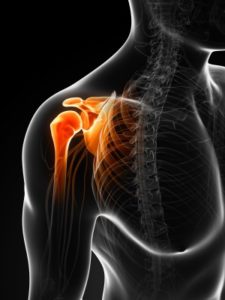Shoulder Pain in Burlington – Is it Calcific Tendinopathy?
Calcific tendinopathy is a relatively common condition affecting tendons. Under most circumstances, it refers to a change in the shoulder that involves calcific deposits forming in a tendon.
Shoulder Pain
Calcific tendinopathy is usually painful. Perhaps this is because you get little bits of calcium crystal deposited in the tendon. Calcific tendinopathy can occur in different tendons but it usually occurs in the shoulder. In the shoulder it usually affects the rotator cuff muscles, especially the supraspinatus muscle. In 25% of cases, it is accompanied by tearing in the rotator cuff tendon (such as the supraspinatus).
Calcific Tendinopathy Cause
The cause for calcific tendinopathy is relatively unknown. Perhaps the most common explanation is that the tendon is overused and there is a reduced blood supply to the area. Through various cellular mechanisms, calcium is gathered in the tissue. Why do some people get this while others don’t? We don’t know; the studies performed on the topic have not found a definitive answer. What we do know is that it is more common in certain populations, like diabetics and those with some autoimmune conditions. That being said, anyone can get calcific tendinopathy. Usually, a person is between 30-50 years of age when they are diagnosed.
Given that calcific tendinopathy involves calcium (a substance with similarities to bone) it can usually be seen on an x-ray. Soft tissue imaging like ultrasound, MRI or CT can be helpful in determining whether there is an associated tear in the tendons of the rotator cuff.
Shoulder Pain Physiotherapy
The treatment for calcific tendinopathy varies. It is definitely a condition that requires an individualized physio plan. For some people, pain control is the priority. For others, the paramount concern may be an associated tear in a rotator cuff tendon like the supraspinatus. Perhaps the most important thing to remember about calcific tendinopathy is that most cases resorb spontaneously. In other words, over time the calcium deposition should resolve. Although some patients have surgery for calcific tendinopathy, non-operative treatment (like physiotherapy or chiropractic) has shown great success, with 90% success rates being suggested in the literature. Corticosteroid injections may reduce the pain associated with calcific tendinopathy but they have not been shown to help with calcium resorption.
At our physiotherapy clinic in Burlington, we take a functional approach to treating shoulder pain associated with calcific tendinopathy. Have certain muscles become weak? Has your movement been affected? A home exercise program is almost always a part of the treatment for this type of shoulder pain. Treatment at the clinic may also be warranted depending on the specific presentation of each patient. Acupuncture or soft tissue therapy is often utilized on surrounding tissues, depending on the situation. Laser therapy can also be used on surrounding muscles to assist in the recovery and to promote healthier tissue in the area of the tendinopathy.
As you can see, there are many avenues of treatment for calcific tendinopathy and there is still much to be learned about the condition. In the meantime, our clinic focuses on a functional recovery for each patient with the idea in mind that in most cases, the calcium deposition resolves with time. The goal is to maintain normal shoulder function in the surrounding areas so that 100% recovery is achieved.
By: Dr. Kevin McIntyre B.Kin., DC
References
Oliva F, Via AG, Maffulli N. Calcific Tendinopathy of the rotator cuff tendons. Sports Medicine & Arthroscopy Reviews 2011; 19(3): 237-243.









